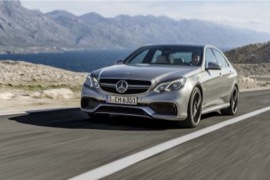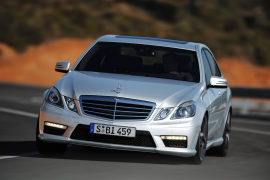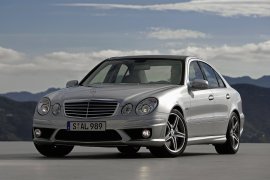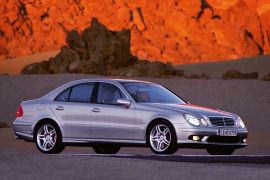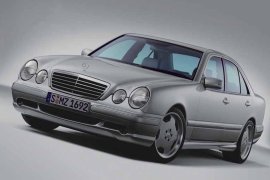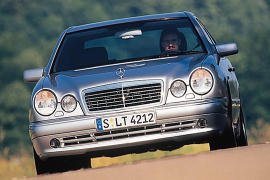MERCEDES BENZ E-Klasse AMG Models/Series Timeline, Specifications & Photos
First production year: 1996
Engines: Gasoline
The 2013 E63 was just the kind of car for someone who was looking for a sports car but didn't want to stand out with an opulent CLS and also didn't want to lose the elegance of a premium elegance and comfortable sedan.
There were some clues to reveal the beast hidden under the somehow conservative sedan. First, it was the grille with the characteristics horizontal chromed double-bar that emerged from the side to the center Mercedes-Benz badge. Then, there were the large air-scoop on the lower part of the bumper and big side-scoops meant for cooling the brakes.
Inside, the car was just a luxurious sedan, with bucket-seats upfront and a wide bench-seat in the rear. Of course, the technology available for the driver was up to date, with a premium infotainment system and all the comfort features for the era, including leather upholstery, heated and ventilated seats plus a specific design for the gear lever.
But the real magic was under the bodywork. Apart from the specification sheet, there were some more details involved in the AMG E63 E-Class. The AMG Carbo-ceramic larger brakes, the adaptive air suspension, and the special AMG SPEEDSHIFT MCT 7-speed sports transmission. The fast sedan could do a 0-100 kph (0-62 mph) sprint in 3.7 seconds. The AMG 4Matic all-wheel-drive system sent the engine torque was distributed to the front and rear axles at a ratio of 33 to 67 percent, but that could be changed if the road conditions were imposed up to a 70 to 30 or 30 to 70 percent.
Mercedes-Benz introduced the mighty E63 version of the E-Class' fourth generation at the 2009 New York Motor Show in April 2009, and it bumped the hearts of car enthusiasts.
It was the last naturally-aspirated E63 AMG before the downsizing trend that forced the German automaker to switch on the bi-turbo technology. Just like many other mid- or executive-sized sedans from Mercedes-Benz, it mixed the grunt of a sportscar with the comfort of a limo. And it did that flawlessly. And, just like its non-AMG brother, the regular W212, it shook the world with its new image.
In AMG clothing, the sedan featured a different front bumper fitted with an A-shaped lower grille than the rest of the W212 range. It was flanked by two side scoops where LED daytime running lights adorned filled the upper sides. The car's profile was visually enhanced by the 18" light-alloy wheels, with an option for a set of 19" in size. It was still subtle, yet the rear end of the car showed the four rectangular pipes that peaked from underneath the bumper.
Since it was a high-performance version of the W212, it didn't come with regular seats. The carmaker installed high-bolstered, leather-wrapped bucket seats at the front and a bench profiled for two in the back. The dashboard was still angular and shared most of its parts with the rest of the E-Class range, but the center console was specific for the AMG version. It was cluttered with more buttons that tuned the suspension, gearbox, and ESP settings. Yet, in normal mode, it felt like a regular E-Class, albeit with the brawling V8 sound from under the hood.
Its 6.2-liter engine was tuned to produce 63 mkg (465 lb-ft) of torque, hence the name, and it was paired with a seven-speed automatic gearbox (wet-clutch, not torque converter) named SPEEDSHIFT. Power went to the rear wheels only via an open-type differential, with an option for an axle-locking one.
Fighting against its main rival, the E60 M5 from BMW, Mercedes-Benz noticed that its E 55 was outnumbered in terms of power, so it decided to change that and unleashed the E63 AMG.
When Mercedes-Benz introduced the facelift for the E-Class' third generation, known as the W211, it dropped the former E 55 AMG model in favor of the larger E 63 AMG. Thus, even though the new model came without a supercharger, it offered a higher power and two more gears for the automatic transmission. Now it could better compete head-to-head with the V10-powered M5 and was even quicker than some supercars. Last but not least, the sound of its naturally-aspirated V8 thrilled its owners and bystanders.
With a revised front fascia that featured a new A-shaped grille in the lower bumper, and four horizontal slats instead of five on the grille, the 2006 E63 AMG was the new big thing in the sports sedan market. On the sides, the automaker installed standard 18" light-alloy wheels with a unique five-spoke design. At the back, the redesigned taillights featured a single, taller, reversing lamp instead of the V-shaped one from its predecessor. To complete the sporty image of the vehicle, AMG also added a lip spoiler on the trunk and four oval-shaped exhausts under the rear bumper.
Inside there were no significant differences compared to the rest of the E-Class range. It sported new dials with a black background inside the dashboard and a new steering wheel. In addition, the AMG version featured aluminum pedals. As an option, the car manufacturer offered an Alcantara-wrapped steering wheel and carbon-fiber trims instead of wood grains.
The engine was a naturally aspirated V8 with a 6.2-liter displacement. The 63 number didn't come from the displacement. It came from the torque, expressed in Newton-meters: 631 (465 lb-ft). It was mated as standard to a 7G-Tronic gearbox.
Mercedes-Benz introduced the W211 E55 AMG version in 2002, offering a performance-oriented sedan for the premium segment. However, unlike the M5 from BMW, its main competitor, it came with an automatic transmission.
In a market where Audi and BMW shared customers with their S6 and M5, respectively, Mercedes-Benz didn't have something special besides the E500 (W124). But that wasn't enough, so the three-pointed-star brand brought AMG into the equation.
Unlike the rest of the W211 range, the AMG version came with a different front fascia that featured a more aggressive bumper fitted with an A-shaped lower grille. That was flanked by a pair of scoops where the automaker installed the fog lamps. In addition, the Xenon headlights were fitted as standard. From its profile, the five double-spoke wheels confirmed the performance-oriented model. Finally, at the back, Mercedes-Benz installed a twin-exhaust pipe with oval-shaped tips.
Inside, the automaker didn't cheap out on using expensive materials. On the clock's dial inside the instrument panel, Mercedes-Benz showed the AMG lettering, so the driver should remember that if time was precious, the high-performance sedan could save the day. Unlike the rest of the range, this version also received high-bolstered front seats with leather upholstery.
Under the hood, the AMG department installed a hand-built 5.4-liter V8 that produced 476 hp (469 PS) thanks to a supercharger. The only transmission available for this special E-Class W211 was a five-speed automatic tuned for quick shifts.
Mercedes-Benz finally decided to remove its gloves and launch a proper sports sedan in 1997 when it introduced the E 55 AMG.
While it previously launched the E 36 AMG and the E 50 AMG, which were produced in small numbers, the first true-to-the-bone AMG for the E-Class was the E 55. Its success was limited only by its hefty price tag, but it was still sold in high numbers that passed the 10,000 units mark. For a sports sedan, that was big. Especially since its interior was second to none regarding quality and amenities.
At first sight, it was difficult to tell the difference between the potent E 55 and the rest of the W210 range. Its front fascia was almost identical, with those love-it or hate-it four headlights. The main difference was on the lower part of the bumper, where the automaker installed an apron fitted with a broad air intake in the middle flanked by smaller scoops on the sides where Mercedes installed the fog lamps as an option. In addition, the car boasted a set of aerodynamically profiled side sills, while at the back, the redesigned bumper almost concealed the twin exhaust that peaked from underneath it.
The two-tone leather seats and the wood trims were specific for this version. The automaker placed the AMG badge inside the speedometer that took center stage in the instrument cluster. But the front bucket seats featured high-bolstered areas since the car was not exactly a mundane vehicle. In the back, Mercedes-Benz also used two-tone upholstery for the front seats.
But the most essential part of the E 55 AMG was underneath the car's skin. First, AMG hand-built the naturally-aspirated 5.4-liter V8. Then, it paired it with a five-speed automatic gearbox that sent the power to the rear wheels. And the result was smashing!
The w210 Mercedes-Benz E-Class E50 AMG was only built for a year, but it was enough to shake the Mercedes world. The mid-size sedan was able to sprint, and roar.
After BMW took the charge with the sport-sedan BMW M5, Mercedes-Benz had to give a proper answer to the Bavarian car-maker and its most fierce competitor. They assigned the AMG tuner to work their magic on the car and the result exceeded expectations.
From the outside, the E50 AMG was hard to distinguish from the regular E-Class. There was a slightly different front bumper. The main difference was at the wheels, which featured a different design with a big center and five wide and short spokes. In the back, since the exhaust pipes were hidden under the rear apron, it was even harder for someone to tell the difference, apart from the chromed E50 badge, which was a zero cost to remove it from the factory.
The interior was usually black with bucket seats in the front and side bolstering. While the E-Class was oriented for a comfortable ride, the AMG was focused on the performance side. The instrument cluster was almost identical with the rest of the range, except for the AMG badge on the speedometer.
The E50 AMG featured the same basic 5.0-liter V8 engine from the E500 model, but with different headers and injection settings. It offered 347 hp and it was mated to a standard 5-speed automatic gearbox. The official record stated that the car was able to rocket from 0 to 100 kph (0-62 mph) in 6.2 seconds, but independent tests showed that it could get as low as 5.8 seconds.
